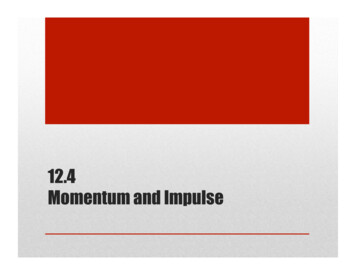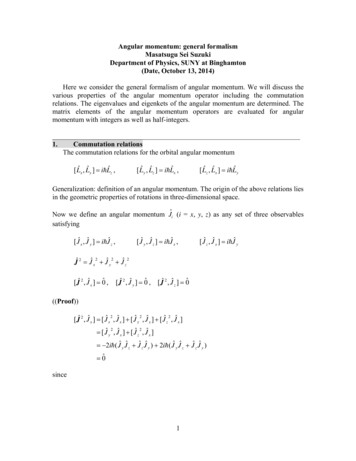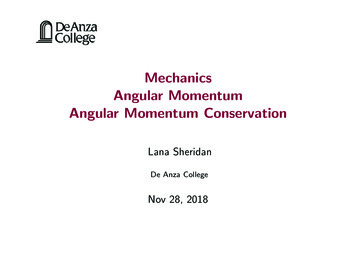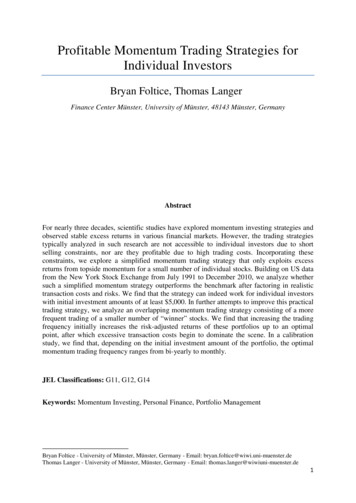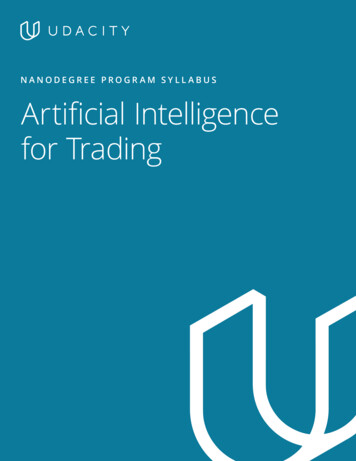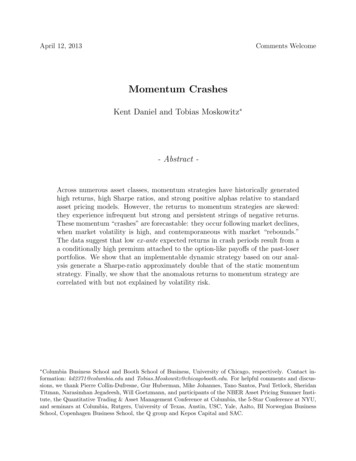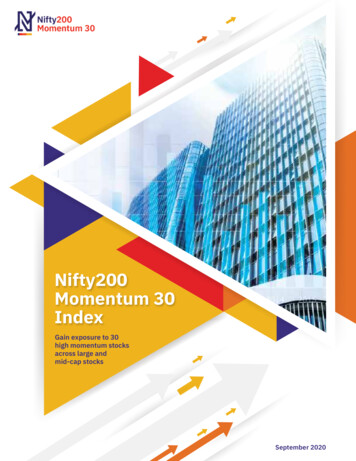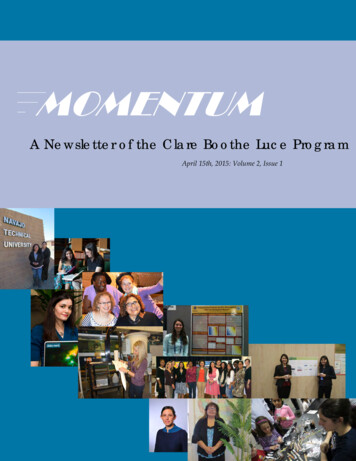
Transcription
MOMENTUMA Newsletter of the Clare Boothe Luce ProgramApril 15th, 2015: Volume 2, Issue 1
Table of ContentsLet’s Go Hunting.4Trinity Washington University’s Genome Annotation InitiativeLiving Lab Takes Root at Olin College.6Two undergraduates imagine a zero-energy campusTaking Flight.8CBL Graduate Fellows prepare for a career in industryJessica Elinburg and Elisabeth McClure, CBL Undergraduate Research Scholars at Emory, interest children inscientific research at the Atlanta Science FestivalThe Start of Something Great.10Catching up with CBL Professor Emily WeissChanged Lives.12The CBL Women’s STEM Tribal College ScholarshipClare Boothe Luce Selection CommitteeJames Piereson, ChairPresidentWilliam E. Simon FoundationJohn C. BravmanPresidentBucknell UniversityModeling the Master Clock.14Undergraduates at Amherst research circadian rhythmsMentorship in Action.16Checking it with Georgia Tech’s Ph.D. candidatesBig Data and Big Developments.17St. John’s University’s first CBL Professor in Computer ScienceAlumna Spotlight.18An interview with Julia FerraioliLiving the Dream.20Midge DecterWriter and CriticA Stonehill CBL Undergraduate Scholar goes to work at NASAInspiring the Community.22Emory students shine at the Atlanta Science FestivalEdwin J. FeulnerFounderThe Heritage FoundationIn Her Own Words.23A Williams sophomore tries out life as a mathematicianClaire L. GaudianiAdjunct ProfessorHeyman Center forPhilanthropy andFundraisingNew York UniversityAbout the Clare Boothe Luce ProgramAmy LiuProfessor and Chair ofPhysicsGeorgetown UniversityCourtesy of the Clare BootheLuce ArchivesSince its first grants in 1989 the Clare BootheLuce Program (CBL) has become the single mostsignificant source of private support for womenin science, mathematics and engineering. ClareBoothe Luce, the widow of Henry R. Luce, wasa playwright, journalist, U.S. Ambassador toItaly, and the first woman elected to Congressfrom Connecticut. In her bequest establishingthis program, she sought “to encourage womento enter, study, graduate, and teach” in science,mathematics and engineering. Thus far, theprogram has supported more than 1900 women.2
Clare Boothe Luce Program Director’s CornerApril 2015 CBL Momentum! NewsletterWelcome to the Spring 2015 edition of the Clare Boothe Luce Program newsletter Momentum! 2014 wasa very exciting year for the CBL Program. Last year, we kicked off activities to celebrate 25 years of theClare Boothe Luce Program with the release of new program brochures and the launch of Momentum! Weare continuing the celebration in 2015 with a Clare Boothe Luce 25th Anniversary Professors Conference.This event is being organized and will be hosted by Clare Boothe Program “Designated Institution” Fordham University at their Lincoln Center (Manhattan) campus. Please see the piece included in this edition formore information about this exciting event!We’d like to thank everyone who took time to submit articles and photos. Please note as you are readingthe articles that CBL Program Guidelines for the “Designated Institutions” (those that were named in Mrs.Luce’s bequest to receive funds in perpetuity), vary somewhat from those for “Invited Institutions” (thosethat participate in the open competition for Clare Boothe Luce grants). For example, Biology is an acceptedfield for Designated Institutions, as this enables the schools named in Mrs. Luce’s bequest to fully capitalizeon their particular institutional strengths in the STEM fields. Also, any international travel mentioned wasfunded by recipients’ institutions, not the CBL program.Congratulations to all of the Clare Boothe Luce Undergraduate Scholars, Graduate Fellows, and Professorsfeatured this edition of Momentum! Please join us again in celebrating their outstanding activities and accomplishments! Enjoy and Happy Spring! Carlotta M. Arthur, Program DirectorMeet the newsletter team!Carlotta M. Arthur – Director, Clare Boothe Luce ProgramCarlotta earned a B.S. in Metallurgical Engineering from Purdue University, and worked for ten years in the aerospace and automotive industries before completing an M.A. and Ph.D. in Clinical Psychology, witha specialty in Psychophysiology, at the State University of New York atStony Brook. Carlotta was a member of the inaugural cohort of the W.K.Kellogg Scholars in Health Disparities postdoctoral fellowship programat the Harvard School of Public Health. Carlotta also taught at MeharryMedical College in Nashville and later at Smith College. Prior to joiningthe Foundation, she served on the staff of the Andrew W. Mellon Foundation. In her free time, Carlotta enjoys yoga, digital photography, jewelrymaking, and travel.From left: Bridget, Carlotta, and EleanorBridget Talone - Clare Boothe Luce Program AssistantA graduate of Sarah Lawrence College, Bridget worked in arts administration and event planning for the GeraldineR. Dodge Poetry Festival and Program before pursuing her M.F.A. at the Iowa Writers Workshop. While at Iowa, Bridgetwas awarded an Iowa Arts Fellowship, The John Logan Poetry Prize and The Donald Justice Award for Poetic Excellence. After graduation, Bridget taught writing at Rosemont College and held an editorial position with the independent poetry press Saturnalia Books. She joined the Foundation in 2013. When she’s not at work, Bridget is either immersed in New York’s vibrant literary scene or looking for a quiet place to write.Eleanor Burgess - Web Editor/Newsletter DesignerEleanor earned a B.A. in History from Yale University, and has taught English, Global History, and Creative Writing atBrookline High School, Hopkins School, and the American School in London. Eleanor is a playwriting fellow at the Huntington Theatre in Boston, and her play Mocha debuted in Austin, TX in 2013. When she is not writing or editing, Eleanoris generally reading, especially history books.3
Let’s Go HuntingThe Trinity Washington UniversityGenome Annotation InitiativeBy Dr. Karobi MoitraHof an organism. By annotating predicted genesave you ever wondered how some organismsstudents can connect these genes to proteins andcan survive in the extreme environment of hotpredict their cellular functions. The larger scientificsprings or in the icy wilderness of the Arctic? Thequestion that this researchsecret lies encoded in theirgenomes within the myriad Dr. Moitra recently travelled project is linked to is – Whatcan the sequence of angenes that make up theirtothe64thAnnualMeetingorganism’s genome tell usgenetic material.about its overall biology?oftheAmericanSocietyofThe Biology/BiochemistryIn order to answer thisstudents at Trinity WashHumanGeneticslastyearquestion we are using theington University under thementorship of Clare Boothe to present the work carried Genomics Education NaLuce Assistant Professortional Initiative- AnnotationCollaboration Toolkit (GEof Molecular Biology, Dr.out by her students.Karobi Moitra are delvingNI-ACT) developed by theJoint Genome Institute’s genomics and bioinformatinto this mystery to understand how methanogensics education program. Students in Introductory(methane producing organisms) like ancient arGenetics and Cell & Molecular Biology classes arechaea (bacteria-like organisms) can survive underannotating predicted genes of Methation Collaboextreme conditions of oxygen deprivation insideunderground sewers. But what exactly is genomeration Toolkit (GENI-ACT) developed by the JointGenome Institute’s genomics and bioinformaticsannotation? It is the process of linking ‘biologicalinformation’ to ‘gene sequences’ in the genomeeducation program.4
Students in Introductory Genetics and Cell & Molecular Biology classes are annotating predictedgenes of Methanothermobacter thermautotrophicusand Methanobacterium sp. SWAN-1 both methanogenic archaea using a virtual learning environmentan electronic laboratory notebook connected to theannotation toolkit.To date the students have annotated over 60 genesand have periodically presented their researchwork in the form of poster symposiums. Dr. Moitrahas also been awarded a travel grant by the Microbial Genome Annotation Network (MGAN) withthe aid of which she travelled to San Diego, CA tothe 64thAnnualMeetingof theAmericanSociety ofHumanGeneticslast yearto presentthe workcarriedout by herstudents.One of Dr. Moitra’s students, shown next toher poster on genome researchThe ge-nome annotationlaboratorymoduleprovidesstudentswith an inquiry-basedprojectwhere students canlearn aboutthe scientificmethod andput it intopractice byhypothesizing protein-codinggenes for asegment ofDr. Moitraa prokaryotic genome.Students collect evidence in support of or againsttheir hypotheses using the toolkit provided inGENI-ACT. This project is a very engaging way tointegrate original scientific research into the curriculum, and we at Trinity have succeeded in creatinga vibrant research environment in which our students can grow and thrive.News from our NetworkThree new CBL program grantees announce their plans to support holars-programFrom the ArchivesUniversity of Colorado’s first ever Clare Boothe Luce -clare-boothe-luce-professorship-award/5
Living Lab Takes Root at Olin CollegeAinvestigating the feasibility of building a living labs first year students, Clare Boothe Luce Unon Olin’s 14-year-old suburban campus.dergraduate Research Scholars Carly IngraoEarly on, the two decided to focus on buildingand Mariko Thorbecke were captivated by the ideasystems rather than starting with the design esthetof creating a living lab on the campus of Olin Colics. “We looked at the heating and cooling of thelege of Engineering. The project had initially beenbuilding. HVAC accounts for 50 percent of a buildconceived by their advisor, Associate Professoring’s energy costs. We took it uponof Design and Mechanical Engiourselves to do some thermal-modneering Professor Ben Linder, as a “This research haseling,” says Thorbecke.way to incorporate environmentaland sustainability practice into the really allowed meAs Ingrao and Thorbecke conclassroom through the creation of a to get my handstinued on with their studies theyzero-energy building with wet laband greenhouse spaces. Net zerodirty in a field I can gained some useful engineeringskills and applied them to their reis the idea that the total amount ofsearch. Specifically, Thorbecke tookenergy used by the building on an see myself gettinga class that explored in-depth heatannual basis is equivalent to theinto and loving.”transfer and fluid dynamics calledamount of renewable energy proTransport Phenomena. The students learned how toduced on the site – a true engineering challenge.use a software tool which allowed them to modifythe flow of heat in different materials thus directlyAlthough it was initially dreamed up by a facultyapplying classroom learning to the project. “Wemember, the Living Lab is a true student-drivenwere able to use knowledge from class to createproject that will model, plan, and design all of thea computer model in simulation software,” Thorsystems (including the solar electric, water catchbecke. They ended up with a schematic drawingment/treatment, and annualized solar gain heatand a thermal design strategy for net-zero buildingsing/cooling systems) for the off-the-grid wet-labin temperate climates.project space. “It was our dream project,” says Carly Ingrao who, with Thorbecke, quickly set aboutIngrao and Thorbecke created a 30–page program summary includinggoals, basic designs, overview of theproject and a cost analysis. With thedocument in hand, Ingrao and Thorbecke presented their project to theVice President of Operations and CIOJoanne Kossuth and the Director of Facilities at Olin College, and to student,faculty, and staff groups on campusand at an international conference inCopenhagen.Ingrao, left, and Thorbecke pose with their research posterBen Linder, the students’ advisor,says the research Ingrao and Thorbecke conducted could have an impactbeyond Olin’s campus. “Carly andMariko are doing the analysis thatneeds to be done to advance the LivingLab project as a truly self-sufficient6
building, and in the process contributing to basicresearch on green building design,” says Linder.Recently, Thorbecke and Ingrao took a minute toreflect back on their experience. “I think the highlight for me was attending a sustainability conference in Copenhagen and presenting our work . . .I don’t quite know where I want to be in 10 or 20years. But I do know I want to be working towardsa more sustainable society,” says Thorbecke. Ingraoechoed those sentiments, “CBL provided me withthe opportunity to not only network with industryprofessionals in the New England area, but to travelacross the world to present among some of thebrightest individuals in many fields of sustainability . . . This research experience has really allowedme to get my hands dirty in a field I can see myselfgetting into and loving.”Ewha Womans University Launches Expanding Horizons program!The Expanding Horizons Program, funded by a Luce Foundation 75th AnniversaryInitiative grant award of 1.5 million to Ewha Womans University, in Seoul, Korea,will launch summer 2015! The program will take place on the Ewha campus,and will be an 18-dayexperience, June 22through July 9th.The program will includeten days of seminarand lecture activity inSTEM fields, tours of STEMresearch and industrialfacilities, and visits toKorean historical sites andcultural attractions. It isparticularly designed toallow ample time for peerinteraction and for oneon-one meetings betweenstudents and facultymembers. Nine to ten ClareBoothe Luce GraduateFellows will be makingthe trip to Seoul andparticipating this summer!They will be joined byan equal number ofparticipants from Asia. Wewill share stories and photosfrom the 2015 ExpandingHorizons program in a lateredition of Momentum!7
TAKINGFLIGHTTwo CBL Graduate Fellows at St. Louis University are doingadvanced academic work with serious implications forindustry - and for other women.Miranda Pizzella and Mary Jennerjohn are completing their second year as Clare Boothe LuceGraduate Fellows at Parks College of Engineering,Aviation and Technology at Saint Louis University.They are pursuing PhDs in Aerospace Engineeringwith a concentration in Thermal Fluid Science.Pizzella uses computational fluid dynamics (CFD)to predict normal shock wave boundary layer interactions. Her research impacts supersonic aircraftinlets, the portion before the engine that makes it gofrom supersonic to subsonic.Jennerjohn’s research impacts efficiency of gasturbine engines. She is involved in designing theParks College Polysonic Wind Tunnel, which willbe capable of subsonic, transonic, and supersonictest conditions and will be used for experimentalresearch.As CBL Graduate Fellows, Pizzella and Jennerjohnhave been taking classes, training on software,doing literature reviews, teaching labs, researching,and mentoring undergraduate students, especiallywomen. Both have authored or co-authored a paper which was presented.Pizella and Jennerjohn have enjoyed being Teaching Assistants (T.A.) in Fluid Dynamics labs. Bothhave also served as Lead T.A. for these labs, ensuring that labs run smoothly, equipment is operatingand T.A.s are grading consistently and covering thecorrect material. Jennerjohn is excited about herwork and loves to share that enthusiasm with thestudents in her labs. “I give a mini-lecture beforeeach lab about how what the students are learningapplies to the real world,” she said. “I think it’simportant for students to understand that.”Mentoring younger women is something thatPizzella and Jennerjohn are passionate about. Theyoften advise undergraduate women about how toprepare for graduate school. In addition, they have8
prepare for graduate school. In addition, they haveparticipated in Introduce a Girl to Engineering Day,an event for high school girls to learn more aboutengineering fields. It is part of the internationalEngineer’s Week. Pizzella and Jennerjohn have hadthe opportunity to talk to girls about what it is likebeing women in a STEM field, how they found theirpaths, and what courses they should take to position themselves for success.While Pizzella and Jennerjohn are mentoring, theyare also being mentored. They are grateful for thesupport they receive from the Dean and faculty atParks College.“I give a mini-lecture beforeeach lab about how whatthe students are learningapplies to the real world,”Jennerjohn said. “I think it’simportant for students tounderstand that.”“We have a great advisor, Dr. Mark McQuilling,”remarked Jennerjohn. “He’s willing to spend timeto mentor and foster opportunities and see us growand succeed as graduate students”.Pizzella agreed. Dr. McQuilling offered her theopportunity to teach two weeks of a Gas Dynamicsclass. She prepared and delivered 50 minute lectures three times each week, held office hours andgave quizzes. “I got to see what a career in academia might be like,” she said.Both women are proud and grateful to be CBLGraduate Fellows. “I would not have been able toattend graduate school without the CBL GraduateFellowship. I’m grateful,” said Jennerjohn.“It means a lot to me that I am supported by theLuce Foundation,” Pizzella added. I’m proud to bea representative for women in STEM fields in theclassroom and labs, to encourage other women togo into these fields.”Mary Jennerjohn at Parks College of Engineering, Aviationand Technology, Saint Louis UniversityWhat’s next for Pizzella and Jennerjohn? Both wereaccepted into the Expanding Horizons programhosted by Ewha Women’s University in Seoul, Korea this summer. Long-term, they are interested inpossible careers in academia, but intend to pursuepositions in industry first.“I want to stay in St. Louis,” remarked Pizzella. “I’llgo into industry for a few years and then maybeinto academia later. I like the idea of interactingwith students.”Jennerjohn agreed. “I’m focused on a career inindustry right now but I do want to continue mentoring other women. That’s important.”“I refuse the compliment that Ithink like a man. Thought hasno sex. One either thinks or onedoes not.”- Clare Boothe Luce9
The Start of Something Great:Checking in with a CBL Professor, Seven Years Onby Steffanee WangAssociate Professor of Chemistry Emily A.And if she’s done her job right, they can more thanWeiss was awarded the Clare Boothe Lucehold their own with her when she reviews theirProfessorship in 2008. Since then, she has goneresearch. “It’s great to argue with them, work withon to receive a number of otherthem and to see their knowledgeimportant fellowships, including “The first-year grads and experience grow,” Weissthe Packard Fellowship for Scisaid. “That’s the most rewardingarebook-smart,butence and Engineering (2010), thepart of being able to work withCamille Dreyfus Teacher-Scholarthey have yet to do my research students.”award (2014), and the Irving M.Klotz Research ProfessorshipIn fact, Weiss finds that her acserious research in(2013).ademic career isn’t only aboutthe lab. During their science, but also about the opporAt Northwestern, Weiss says,tunity to mentor and motivatefirst year or two,she has received a great deal ofothers. “It’s a bit of psychology,theylearnmoreencouragement and support. Shelearning what makes people tick,”believes the Clare Boothe Luceshe said. “I also like gatheringthantheyeverdidProfessorship was an importantdata and attacking complex probfactor in pushing her career forlems and the chance that you’llbefore.”ward, and that it helped to createcome up with something thata momentum that is very valuable to young scienmakes an impact. That’s really motivating.”tists.Weiss has since been invited to speak and presenther work at numerous conferences, including the2014 American Chemical Society conference inDallas, where she was named the Kavli EmergingLeader in Chemistry. About 1,500 people attended her lecture — “probably the largest audienceI’ll have in my career,” Weiss said. Her talk wasbroadcast on YouTube, and she gained furtherexposure from a webinar and a press conference.Weiss’ research group at Northwestern focuseson energy conversion. Working with a group ofabout 20 graduate and post-graduate students,she studies the movement of electrical currentsbetween complex materials. Leading such a team,she says, is another enriching and rewarding partof her career.“The first-year grads are book-smart, but theyhave yet to do serious research in the lab,” Weisssaid. “During their first year or two, they learnmore than they ever did before about chemistry.”Emily A. Weiss, awarded a CBL Professorship in 200810
Clare Boothe Luce Programto Mark 25 Years WithConference for ProfessorsIn November, the Clare Boothe Luce Program will mark its 25th anniversary with an event in NewYork City featuring some of today’s most accomplished women in the sciences, including aonetime science advisor to President Bill Clinton and the first woman to become a full professorof chemistry at Harvard.The event—titled Women in STEM Leadership: Clare Boothe Luce 25th Anniversary ProfessorsConference—will be held Nov. 8 and 9 at Fordham University, and it will celebrate all that theprogram has done to inspire women to pursue careers in science, technology, engineering andmath (STEM) since its founding.“Fordham is honored to partner with the Henry Luce Foundation in marking this importantmilestone for the Clare Boothe Luce Program,” said Amy Tuininga, interim chief research officerand interim associate vice president for academic affairs at Fordham. “This will be an insightfuland inspiring event that highlights just some of the exciting work being done by women in STEMtoday.”Two women will give keynote addresses: former CBL Selection Committee member CynthiaFriend, the T.W. Richards Professor of Chemistry at Harvard and director of the university’sRowland Institute, and Shirley Malcom, head of education and human resource programs atthe American Association for the Advancement of Science and former member of PresidentClinton’s Committee of Advisors on Science and Technology.The conference will take place Nov. 8 and 9 at Fordham’s Lincoln Center campus in the heartof Manhattan, and will be open to Clare Boothe Luce Professors from across the country. It willinclude poster presentations as well as breakout sessions on teaching female students to beleaders in science, mentoring non-science students, innovations in science and technology, andincorporating assessment into student learning, among other topics.11
For Four Tribal CollegeScholarship Recipients, adegree from Navajo TechnicalUniversity Provides a New Wayto Help Navajo NationFor most Native Americans living on Indianreservations, college is only a distant dream.Native Americans account for less than one percentof college students in America today, primarily dueto dire financial need. Only 1 in 20 of Native scholarship recipients with the American Indian CollegeFund (the College Fund) can afford to attend college without financial assistance. On the NavajoReservation, the nation’s largest Indian reservation,only 7% of people have a college degree and 42%live in poverty. But thanks to a Clare Boothe LuceWomen’s STEM Tribal College Scholarship throughthe College Fund, four Navajo women will defeatthose odds. Founded in 1989, the American IndianCollege Fund has been the nation’s largest providerof support for Native higher education for 25 years.Adriane Tenequer, Kierra Nalwood, LaverneMoore, and Ophelia Descheny-Burnside receivedAdriane Tenequer and Laverne Moorethe Clare Boothe Luce Women’s STEM TribalCollege Scholarship in 2014. All four women arestudents at Navajo Technical University in CrownPoint, New Mexico.Adriane Tenequer is a third-year Industrial Engineering major and a single mother of two youngboys. She says juggling home life, raising children,and going to school at the same time is hard, buther scholarship helps her to achieve her dreams.Adriane adds that working hard allows her to bea good role model for her children while emphasizing the importance of education. “I’m breakingthe cycle of poverty; I’m setting and accomplishinggoals; and gaining experience in my everyday life.I’m not settling for what I have around me, butinstead I’m climbing the ladder to show that we canaccomplish anything we set our minds to.”12
Kierra Nalwood is in her first year of industrialengineering studies. She always thought her futurewould include dropping out of high school like hertwo older brothers had. Yet one of those brothersencouraged her toenroll at the uni“I’m not settlingversity to becomefor what I havean engineer. Herfirst year at schoolaround me,has taught Kierra that “my faithbut instead I’mand education areclimbing the ladall that I have; Ido not want toder to show thatlose them.” Kierra plans to workwe can accomfor Indian HealthServices as a field plish anything weengineer afterset our minds to”graduation.Ophelia Descheny-Burnside is the sole support ofher family due to her husband’s health problems.After earning an associate’s degree at Diné College,also located on her reservation, she transferredto the University of Arizona. However, Opheliamissed the scholastic support and guidance shereceived at a smaller school. She decided to enrollat NavajoTechnicalUniversityon her reservation.Kierra Nalwood“Theclassroomswere notas full; Igot a lot ofattentionand tutoring whileattendinga smallercollege onthe Navajo Nation. Theteacherthat I wasworkingOphelia Descheny Burnsidewith at the school where I was employed was veryunderstanding. I was able to take some time offfor college assignments that I needed to complete,using the classroom computer to type my assignments,” Ophelia says. Unfortunately, she foundherself wondering how she would complete hereducation until she was awarded a scholarship.She says, “This means a lot to us students who areexperiencing financial difficulties while obtainingour degrees. Without your support, we are unableto accomplish our goals. Many students drop outdue to no funding and cannot get anywhere withlimited finances.”Laverne Moore, a second-year computer sciencemajor, was in an accident that left her briefly unableto walk last year; however, this summer she willbe able to stay in school and complete her mathrequirements and focus solely on her core classeswhile applying for internships.All four of the women state that thanks to thefinancial support of the Clare Boothe Luce Women’s STEM Tribal College Scholarship and theknowledge that someone believes in them, theycan focus on their studies, assured that achievingtheir dreams of giving back to their communityafter graduation are that much closer to becoming areality.13
MODELING THE“MASTER CLOCK”Above, from left: Shelly Tang, ProfessorTanya Leise, and Melody Owen(Copyright Transit Authority Figures)Undergraduates at Amherst College learn aboutresearch as they investigate Circadian RhythmsBefore last summer, Amherst College studentsMelody Owen ’17 and Shelly Tang ’17 hadheard the term “circadian clock,” but like most people, lacked an understanding of how this internalmechanism for regulating daily rhythms of activity,metabolism, and sleep actually works.That changed soon after they were both invited tobecome Clare Boothe Luce Undergraduate ResearchScholars and undertake a research project underthe guidance of Associate Professor of Mathematics Tanya Leise. Leise’s research focuses on usingmathematical modeling combined with time-frequency analysis to improve our understanding ofhow our circadian clock works and what can gowrong.Professor Leise encouraged Shelly and Melody tolead the way in developing an independent project.To prepare for their research, the students dug intoscientific papers to learn about the suprachiasmaticnucleus (SCN), a cluster of neurons in the hypo-thalamus that forms the main circadian clock in ourbody. The SCN tracks time of day, can be reset bylight, and aligns the clocks in tissues throughoutour bodies to function in an optimally coordinatedmanner.Professor Leise guided them in writing scripts inMATLAB, a powerful software tool, to simulate amathematical model of the neuronal network in theSCN in order to study how the individual neuronscoordinate to sustain a robust internal clock. Asrising sophomores, both students were very newto both programming and mathematical modeling.Shelly explains, “At the beginning I knew nothingabout MATLAB. Through Professor Leise’s instruction as well as studying sample code, I learned towrite simple scripts, and could also understandslightly more complicated ones.”The team modeled a network of oscillators, adjusting the strength of coupling in the network toobserve the resulting change in the degree of syn-14
-chronization. The aim of the modeling was toexamine ways to strengthen the SCN network,through exposure to bright light during the dayand regular exercise for instance, to mitigate theeffect of aging on the clock.several different paths before finding the right one,and they encouraged the students to feel empowered to pursue new directions and not be afraid tojump off the beaten track.“I was surprised to findout h
About the Clare Boothe Luce Program Since its first grants in 1989 the Clare Boothe Luce Program (CBL) has become the single most significant source of private support for women in science, mathematics and engineering. Clare Boothe Luce, the widow of Henry R. Luce, was a playwright, journalist, U.S. Ambassador to
